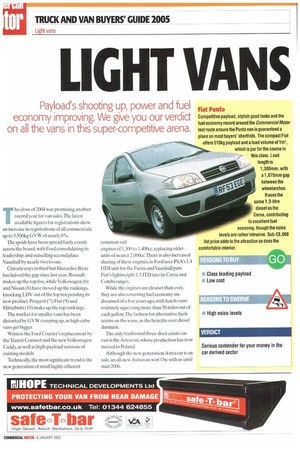LIGHT VANS
Page 8

If you've noticed an error in this article please click here to report it so we can fix it.
Payload's shooting up, power and fuel economy improving. We give you our verdict on all the vans in this super-competitive arena.
The close of 2004 was promising another record year for van sales. The latest available figures for registrations show an increase in registrations of all commercials up to 3,500kg GVW of nearly 8%.
The spoils have been spread fairly evenly across the board, with Ford consolidating its leadership, and outselling second place Vauxhall by nearly two to one.
Citroen stays in third but Mercedes-Benz has halved the gap since last year. Renault makes up the top five, while Volkswagen (6) and Nissan (8) have moved up the rankings, knocking LDV out of the top ten pending its new product. Peugeot (7), Fiat (9) and Mitsubishi (10) make up the top rankings.
The market for smaller vans has been distorted by GVVV creeping up, as high-cube vans get bigger.
Witness the Ford Courier's replacement by theTransit Connect and the new Volkswagen Caddy, as well as high-payload versions of existing models.
Technically, the most significant trend is the new generation of small highly efficient common-rail engines of 1,300 to 1,400cc, replacing older units of nearer 2,000cc.There is also increased sharing of these engines, as Ford uses PSA's 1.4 HDI unit for the Fiesta and Vauxhall puts Fiat's lightweight 1.3 JTD into its Corsa and Combi ranges.
While the engines are cleaner than ever. they are also returning fuel economy undreamed of a few years ago, with hatch-vans routinely squeezing more than 50 miles out of each gallon:Me fashion for alternative fuels seems on the wane, as the benefits over diesel diminish.
The only traditional three-door estate car van is the Astravan, whose production has now moved to Poland.
Although the new generation Astra car is on sale, an all-new Astravan won't be with us until mid-2006.
















































































































































































